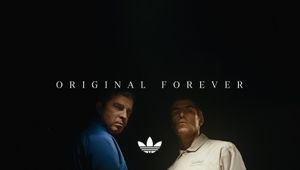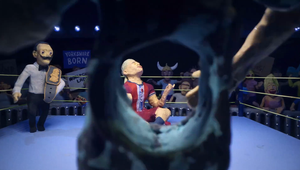
Breaking the Mould of Gigacity Advertising for Qiddiya

Currently, around 40km from the centre of Riyadh in Saudi Arabia, the first ever ‘city of play’ is being built. Yup, you read that right - Qiddiya City is the newest giant entertainment destination. An ADHD mind’s heaven, Qiddiya’s city planning always puts play first - residences are being built amongst theme parks and golf centres, housing is equipped with game rooms, and major sporting events, performance arts and gaming events are planned to be on every doorstep.
The city promises 25 unique district master plans offering entertainment, sports and culture with mixed-use areas, residential communities and, we can’t forget, nature. Expected to be home to more than 600,000 residents, Qiddiya is gearing up to welcome millions of thrill-seekers yearly, and house over 400 tourist attractions.
To introduce Saudi Arabia’s new project as well as start to realise its motto ‘Play Life’, Droga5, Accenture Song and ProdCo UK came together to create the city’s first ever campaign. Unlike other gigacity marketing efforts, this spot strays away from glossy CGI, and instead zooms in on the “transformative power of play.”
In the film, the opening scene presents us with people engaging in uninspired, lacklustre entertainment - kicking a football, watching motor racing, playing a video game. Soon enough, the items of play take a life of their own, sucking their players into a world of endless entertainment, where they quickly become Player One.
“Qiddiya has a unique architectural layout,” explains ProdCo UK director Nick Roney. “There will be rollercoasters running through office buildings and a massive water park that overlooks an F1 track. Everyday life will be interwoven with the world’s biggest amusement park. The idea is probably best summed up by their philosophy: ‘You don’t live life, you play life.’ Droga5 had a strong script that spoke to that theme with the core characters and structure already laid out. Our job was to make the journey cinematic and find ways to humanise the inanimate characters.”
The point of the spot was to make the city of play relatable, not just a distant, imaginary possibility. It’s here and it’s now, and it’s waiting for you, not anybody else. The people in the spot are regular, everyday folks, engaging in activities that they have stopped seeing as play because of their monotonous daily lives. But the facts are simple - even rocking back and forth on a wooden horse is play. And Qiddiya can up the game even on that.

“The main objective was to let people know that Qiddiya is a destination for everyone. We tried to give the film global appeal by including as many nationalities as possible,” says Nick. Production designer Robin Brown filled the sets with amazing details authentic to each represented country. “Everything from the make and model of vehicles down to the street signs was spot on.” Another part of the global approach was ensuring that the actors playing a scene in a certain part of the world were actually from there. “Hopefully, all of this created an inclusive quality that broadened the appeal of the campaign.”
And because the city has such a vast array of attractions, Droga5 and ProdCo attempted to represent as many of them as they could in the characters. “Most of the roles originated in Droga’s script and we just looked for ways to inject personality. For example, the bowling ball became a bowling ball with a bowler being dragged behind it. There were a few characters we added though, like the girl on the mechanical horse and the rollercoaster. We figured the best way to make the film feel like a ride was to literally put one in it.”
But, because there were so many characters and the time was limited, creating nuance in them was a challenge. “We tend to gravitate toward unique looking people with uncanny mannerisms to add a level of specificity,” Nick explains. “Instead of testing for just the action in the script, we had them do an improv where they would invent what takes place before and after that scene.”
For example, for a part that requires surprise, the team would have one actor propose to another using numbers for dialogue - this way they ensured they could focus on performance rather than script. “Invariably, the actors that were most creative and could make ridiculous games like that feel real, got the part.”
Cinematography wise, DP Erik Messerschmidt put to work his effortless way of shooting - “deceptively simple,” as Nick calls it. “We were blown away by the images on the monitor and then looked around and only saw one light on set. Some of his genius comes from an expert understanding of light and knowing how to work with what the location naturally provides. It never seemed like he was fighting the elements.”

The camera was a Red Raptor, with some bits being shot on the Komodo using Zeiss Supreme Prime Radiance lenses. With nothing running through LUTs, Erik would manually adjust the colour temperature in camera to create the base look for the film. Then, he would send extremely specific notes to Black Kite colourist Tom Mangham such as “Bring back the saturation here by 4%”, “Adjust this by a ¼ stop”, and others. And while many might think micro adjustments like these might not bear a noticeable difference, over time they add up to create striking images with unexpected mood.
“We tried to give each scene a distinctive and different look and gradually to bring them all together towards the end of the commercial,” says colourist Tom. “To help achieve this, I was provided with references for each scene, picking out frames from films that gave me a good idea of the direction we wanted to explore. From there, it was a case of us sitting down and experimenting with these looks until we found what felt right.”
Black Kite Studios, who worked on the VFX on the spot also chimed in about the two-week shoot in Barcelona, which for them culminated in a two-day studio shoot for the green-screen elements and set builds for the motion control sequences.
Because of the large amount of VFX shots, Black Kite sent two VFX supervisors to attend the shoot, working both in tandem and separately to capture the data. “From a post-production standpoint, it was an ambitious and exciting project with an array of VFX shots each calling for a bespoke execution,” says Guillaume Weiss, VFX lead and head of 2D.
He continues: “We were tasked with creating large CG crowds, inflatables, a Formula 1 car, football, body doubles, a fairground rollercoaster, and a good helping of FX for destruction and interactions.” Environments in the film were either enhanced or created from the ground up. For example, the fairground park, the desert wides and the cliff edge in the final shot.

“We captured plates and references for all setups, allowing our team of lighters, animators and FX artists to faithfully recreate any elements in CG.” And, where possible, real world references were used - golf balls on a stick, stand-in inflatables on strings and partial set builds to be augmented in post.
About one of the scenes, the stampede, Guillaume explains that the team had to capture as much as possible of the main talent in camera within the correct locations, making use of practical rigs that would later be removed in post.
“There were a couple of motion controlled sequences in the longer edit which had to be carefully planned and rehearsed, as well as a handful of plated shots where timings and line-up would be crucial,” says Guillaume. “Motion control meant that we could capture multiple plates and rig in-camera interactions with the talent on the set. The final result would be a mixture of practical and CGI, both exactly synced to a dramatic ramping camera move in bullet time.”
When it came to music and sound, the idea to use the song in the final film - the title track from Truffault’s ‘The 400 Blows’ - came right away to Nick's mind. “It’s whimsical with monumental scope and some haunting undertones, which gave the film an unexpected feeling,” he adds. The team was after a track that had a vintage quality to it, with real musicians and instruments to ground all of the modern VFX.

Will Cohen at String and Tins worked with composer Guy Farley to reengineer the song, so it would fit the film like a glove. “Another of Will’s focuses was to give the SFX in the opening a musicality. The lead creative wanted to illustrate the monotony of restricted play through repetitive sounds that built into a song - a playful way to make the boredom fun.”
The very memorable end frame of the film - where we see the entire group of characters standing at the edge of a cliff - was an important one to include, as it is significant to the location where Qiddiya will be built. “There’s nothing of the city that can be filmed yet, so the rock face is the symbolic placeholder of what’s to come,” say Nick. “Black Kite went to the desert just outside Riyadh and scanned it with a drone so they could digitally recreate the location with 100% accuracy.”
“The shoot was a blast,” concludes Nick. Naturally, because all the scenes were related to play they say that the teams engaged in not one or two bowling games and overall, play was encouraged on set. Keep your eyes peeled for what happens next in Qiddiya.















